|
THIS IS AN OLDER PAGE - FOR CURRENT INFO PLEASE GO HERE
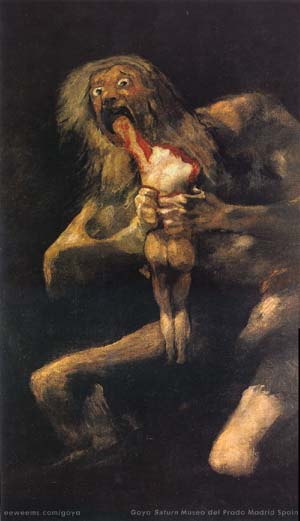
To view enlargement please click on the image

The Black Paintings
SATURN
also called
Saturn Devouring his Son
Saturno devorando a su hijo
1820 – 1823 Oil on plaster
57 1/2 inches x 32 3/4 inches
146 cm x 83 cm
Museo del Prado, Madrid Spain
Though this painting is called "Saturn" and seems rooted in showing the mythological character that devoured his son, there are, like many of the other 'Black Paintings' a certain disconnection between any strict understanding of the ancient tale versus Goya's depiction of it. While the other famous rendition of the story by Peter Paul Rubens (image below) carefully illustrates the story in detail, with this picture by Goya there is variation and improvisation.
Rubens's picture shows Saturn in his jealousy and  fear destroying his progeny, a more or less reasonable action within the confines of mythological tales. The gods take dramatic action, deeds that on a purely human scale are absurd, but in that hyper-dramatic genre make sense. In Goya's image, though, there is no context of legend, but instead a stripped-down scene of cannibalistic horror. fear destroying his progeny, a more or less reasonable action within the confines of mythological tales. The gods take dramatic action, deeds that on a purely human scale are absurd, but in that hyper-dramatic genre make sense. In Goya's image, though, there is no context of legend, but instead a stripped-down scene of cannibalistic horror.
What is Goya's improvisation on this familiar icon of art and literature? For one, he renders it blatantly insane, Saturn shown without any recognizable expression of premeditation. Another is no context given of the ethical system of mythology. What system could explain this picture? Apostle Paul said that the heathen do not worship gods, but demons masquerading. Has Goya stripped away all the academic and literary cloakings for Saturn and thrown out this portrait as a simple bit of Christian dogma, however dark and crazed?
There are a number of explanations given in art history for this image existing, some psychological connection made to Goya's personal life that explains it via his relationship to his son Xavier, or through Leocadia Weiss his live-in housekeeper, or as an editorial statement about old age or even a political statement about then Spanish King Ferdinand. But if Goya said anything to explain why he painted it this way, it has not survived, and all the explanations are guesses. He rendered the picture quickly and without the technical gloss and fine finish he was quite capable of doing when a particular painting was to be shown in public. That, probably more than anything else, says that Goya had little, if any, investment in making sure an intended audience understood the picture. - Erik Weems
From a reader:
This is one of my favorite paintings because it was done purely as an expression from the artist and was never intended to be seen by anyone but Goya. You can almost feel the painter's bitterness and anger over the civil strife that was going on in his country at the time and the bleak outlook on humanity that he had. You can picture him covering up the pleasant scenes that were already on the walls with black paint, turning an idyllic mountain landscape into a dark and foreboding image. As much as I enjoy the painting, I do feel a bit of sympathy for the live-in housekeeper. Saturn Devouring His Son is one of 14 "Black Paintings" Goya did on the walls of his house. This one resided in the dining room along with 5 others. Imagine sitting down to dinner across from this! The dread and uneasiness one must have felt in the house would probably be similar to the feeling one has when they have a meeting with a Houston DWI attorney coming up. If anyone is
interested in learning more about Goya during the "Black Paintings" time period or would like to see the other works, the Wikipedia entry is an excellent resource.
 ...take the painting that for most people is the ...take the painting that for most people is the 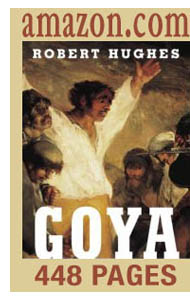 most melodramatically horrible of the lot. Saturn Devouring his Son. Actually, the gory cadaver may be a son or a daughter, its gender is undecidable; but its proportions are certainly those of an adult body and not, as in Ruben's painting of the same theme, which was the origin of Goya's idea, a chubby infant. Originally, as noted earlier, Goya had a standing figure, doing what seems to be a dance step, against a mountainous landscape; this may have even been an image of life's joy. But then the darkness closed in, the background was painted out, and Saturn – god of melancholy and, presiding over the saturnine temperament," the deity of painters as well – filled the whole frame. most melodramatically horrible of the lot. Saturn Devouring his Son. Actually, the gory cadaver may be a son or a daughter, its gender is undecidable; but its proportions are certainly those of an adult body and not, as in Ruben's painting of the same theme, which was the origin of Goya's idea, a chubby infant. Originally, as noted earlier, Goya had a standing figure, doing what seems to be a dance step, against a mountainous landscape; this may have even been an image of life's joy. But then the darkness closed in, the background was painted out, and Saturn – god of melancholy and, presiding over the saturnine temperament," the deity of painters as well – filled the whole frame. Robert Hughes, from his book Goya, published by Alfred Knopf 2003, page 383 Robert Hughes, from his book Goya, published by Alfred Knopf 2003, page 383
 Goya's version of the myth, if indeed it has any relation whatsoever to Saturn, makes no allowance for anything but madness and ferocity. While Rubens's figures act out their destiny in a dramatically convincing, ultimately rational way, there is nothing but silence in the Goya. Goya's version of the myth, if indeed it has any relation whatsoever to Saturn, makes no allowance for anything but madness and ferocity. While Rubens's figures act out their destiny in a dramatically convincing, ultimately rational way, there is nothing but silence in the Goya. Fred Licht, from his book Goya, published by Abbeville Press 2001, page 220 Fred Licht, from his book Goya, published by Abbeville Press 2001, page 220
 Rubens's Saturn, is outwardly more refined than Goya's, but remains the more horrific of the two. The viewer's sympathy is directed toward the baby, yet to be eaten, and Saturn appears a cruel, and corrupt power. Afraid of losing his great strength, he seems remorseless, unaware of the figure of death behind him. Rubens's Saturn, is outwardly more refined than Goya's, but remains the more horrific of the two. The viewer's sympathy is directed toward the baby, yet to be eaten, and Saturn appears a cruel, and corrupt power. Afraid of losing his great strength, he seems remorseless, unaware of the figure of death behind him. Patricia Wright, from her book Eyewitness Art: Goya, published by DK books 1993, pag 51. Patricia Wright, from her book Eyewitness Art: Goya, published by DK books 1993, pag 51.
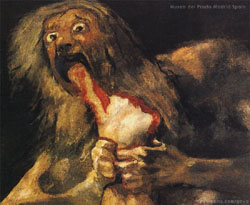
Detail enlargement
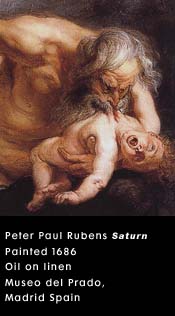
[below] Sketch of the subject Saturn by Goya
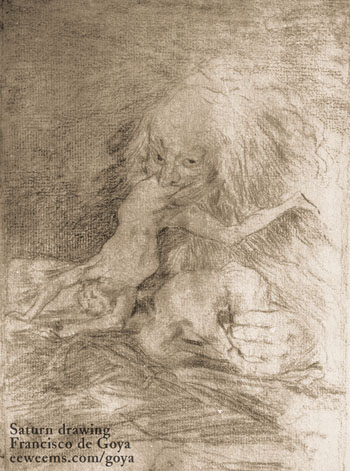
THE BLACK PAINTINGS SPECIAL SECTION
|